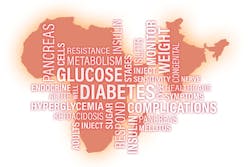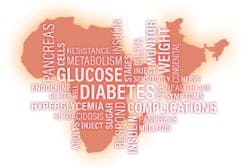Diabetes will increase across sub-Saharan Africa
As sub-Saharan African countries struggle to cope with the current burden of diabetes, new estimates suggest that costs associated with the disease could more than double and may reach up to $59.3 billion per year by 2030 if type 2 diabetes cases continue to increase.
A new report, “Diabetes in sub-Saharan Africa: from clinical care to health policy,” published in The Lancet Diabetes and Endocrinology, asserts that diabetes and its complications have the potential to reverse some of the health gains that have been seen in sub-Saharan Africa in recent years—overwhelming the region’s health systems and crippling patients’ personal finances as they pay for their own healthcare.
Key messages
The Lancet Diabetes & Endocrinology Commission on diabetes in sub-Saharan Africa was launched in London in July. It provides a comprehensive and up-to-date analysis of the burden of diabetes across sub-Saharan Africa and the challenges this burden poses for health systems, as well as potential solutions. More than 70 experts from around the world contributed to the report, which provides five key messages.
- The true burden of diabetes, other cardiovascular risk factors, and macrovascular and microvascular complications in sub-Saharan Africa is unknown.
- Diabetes and its consequences are costly to patients and economies.
- Health systems in countries in sub-Saharan Africa are unable to cope with the current burden of diabetes and its complications.
- Scarce healthcare resources should be focused on the management of diabetes and other risk factors to prevent complications.
- More evidence is needed about the benefits and risks (to individuals and health systems) of screening before programs are rolled out across sub-Saharan Africa.
In recent years, rapid societal transitions that are producing increases in wealth, urbanization, changing lifestyle and eating habits, more sedentary work practices, and aging populations across sub-Saharan African countries have led to increased risk of type 2 diabetes.
An increasing burden
The report estimates that the economic cost of diabetes in sub-Saharan Africa in 2015 totaled $19.5 billion, equivalent to 1.2 percent gross domestic product (GDP). On average, countries in the region spend 5.5 percent of their GDP on health.
More than half of this economic cost (56 percent, $10.8 billion) was spent on accessing diabetes treatment, including medication and hospital stays, and one-half of these costs were out-of-pocket (paid for by the patients). This put a huge financial burden on people with diabetes. The remaining economic costs were a result of productivity losses, mostly from early death ($7.9 billion), as well as people leaving the workforce early ($0.5 billion), taking sick leave ($0.2 billion), and being less productive at work due to poor health ($0.07 billion).
Predicting future impact
To measure the future impact of increased diabetes rates across all sub-Saharan African countries, the researchers modeled three scenarios to show optimistic and pessimistic projections. Their estimates suggest that, in an optimistic scenario, where diabetes death rates and prevalence remain the same for each country, the annual cost of diabetes would increase to $35.3 billion (1.1 percent GDP) in 2030. However, if these rates increased in line with the projected rise in each country’s income levels, economic costs would be $47.3 billion (1.4 percent GDP), and if rates doubled, the costs could total $59.3 billion (1.8 percent GDP).
Wealthier areas of sub-Saharan Africa seeing more societal changes had the highest rates of diabetes in 2015, with almost two-thirds of the region’s diabetes costs coming from southern Africa (62 percent, $12.1 billion), in particular, wealthier South Africa. Less than a tenth of the costs (9 percent, $1.7 billion) originated from poorer countries in western Africa.
In the projections for 2030, southern Africa is likely to see the greatest increases in annual costs, increasing to between $17.2 and $29.2 billion. However, the authors also predicted substantial growth in costs in eastern African countries (such as Ethiopia, Kenya, and Tanzania), increasing from $3.8 billion in 2015 to up to $16.2 billion in 2030.
The Commission’s analyses demonstrate a clear need for improvements at all levels of diabetes care. However, after decades of treating acute infectious diseases, health systems in sub-Saharan African countries are ill-prepared to handle the chronic disease.
The authors of the Commission report conclude that gaps in care include a lack of equipment for diagnosing and monitoring diabetes, lack of treatments, and lack of knowledge about the disease among available healthcare providers. These gaps contribute to the fact that half of patients go undiagnosed, while only one in 10 receive the drugs they need. Many patients face delayed diagnosis and treatment, meaning the disease progresses and causes further ill health and risk of complications—for example, myocardial infarction, blindness, and stroke—which are difficult and expensive to treat.
Addressing the challenge
In order to counter these issues effectively, the researchers recommend rapidly scaling up interventions successfully trialed in sub-Saharan African countries, such as community-based care for high blood pressure, patient education, home glucose monitoring, and more education about diabetes for healthcare professionals.
With the management of type 2 diabetes and its risk factors (such as obesity and physical inactivity) being simpler and cheaper than treating complications of later stage disease, the researchers note that prevention of disease onset and complications will be crucial to improve health and avoid further economic burden.
Writing in a linked Comment, Dr. Shabbar Jaffar, Liverpool School of Tropical Medicine, UK, says: “The prevalence of diabetes in sub-Saharan Africa has increased rapidly in the past 10 years or so, affecting people in all sectors of society but, in particular, and disproportionally compared with high-income settings, affecting younger people, with substantial economic effects. A repeating theme throughout the report is the scarcity of reliable evidence about diabetes in the region—for example, about the true magnitude of the burden of disease and its complications, and what interventions will or will not be effective in the sub-Saharan African context. Despite the scarcity of evidence, several simple and vital conclusions emerge from the report.”
Source: Burden of diabetes set to increase across sub-Saharan Africa. https://www.eurekalert.org/pub_releases/2017-07/tl-tld070417.php
Diabetes is increasing among poorer urban residents in India
India’s diabetes epidemic is shifting, with the disease now increasingly common among people from low socio-economic backgrounds living in urban areas of the more affluent states, according to a study published in The Lancet Diabetes & Endocrinology (“Prevalence of diabetes and prediabetes in 15 states of India: results from the ICMR–INDIAB population-based cross-sectional study”). The authors say the findings should cause concern in a country where most treatment costs are paid out-of-pocket by patients, and highlight the urgent need for effective prevention measures.
The Indian Council of Medical Research—India Diabetes (ICMR-INDIAB) study is the largest nationally representative study of diabetes in India and includes data from 57,000 people across 15 states. As part of the study, each person had his or her weight, height, waist circumference, and blood pressure measured. Glucose tolerance tests were used to diagnose diabetes and pre-diabetes.
The prevalence of diabetes across all 15 states was 7.3 percent. Rates varied from 4.3 percent in Bihar to 13.6 percent in Chandigarh. Almost half of the people in the study did not know they had diabetes until they were tested.
Comparing urban and rural
On average, diabetes was twice as common in urban areas (11.2 percent) compared to rural areas (5.2 percent). Overall, diabetes was more common among people with higher socioeconomic status, compared to people with low socio-economic status. However, in urban areas in seven states—most of which rank among the more economically advanced states—diabetes was higher among people of low socioeconomic status.
For example, in urban areas of Chandigarh, the rate of diabetes was 26.9 percent among people with low socioeconomic backgrounds, compared to 12.9 percent for people with high socioeconomic backgrounds. In urban areas of Punjab, the rates were 16.1 percent and 11.9 percent, respectively.
Additionally, the rates of diabetes in rural areas were much higher than those identified in previous studies. The authors note that since 70 percent of the population in India lives in rural areas, even small increases can translate into several million more people requiring chronic care in areas with poor access to healthcare.
A disease of the poor?
“Our study suggests that cities in the country’s more affluent states have transitioned further along the diabetes epidemic. As the overall prosperity of individual states and the country as a whole increases, the diabetes epidemic is likely to disproportionately affect the poorer sections of society, a transition that has already been seen in high-income countries,” explains senior author Dr. Viswanathan Mohan, President, Madras Diabetes Research Foundation, Chennai, India, the national coordinating center for the study.
“This trend is a matter of great concern because it suggests that the diabetes epidemic is spreading to individuals who can least afford to pay for its management,” adds Dr. R.M. Anjana, lead author of the study, Vice-President, Madras Diabetes Research Foundation
High rates of prediabetes
Prevalence of pre-diabetes was 10.3 percent across all 15 states, varying from six percent in Mizoram to 14.7 percent in Tripura. In most states, the rate of prediabetes exceeded the rate of diabetes.
“The high rates of prediabetes across the country imply the existence of a huge number of individuals who could conceivably develop diabetes in the near future. Our findings have serious implications for the country’s health and socioeconomic development and highlight the urgent need for implementing effective preventative measures,” says Dr. Mohan. The authors note that the study did not differentiate between type 1 and type 2 diabetes.
Writing in a linked Comment, Dr. Vijay Viswanathan, M V Hospital for Diabetes, Chennai, India, says: “The management of type 2 diabetes varies widely in different parts of India. Whereas some people living in urban parts of the country have access to excellent diabetes care services and can afford the out-of-pocket expenditure associated with diabetes, people living in semi-urban and rural areas of the country do not have access to the diabetes centers or clinics that provide comprehensive diabetes care. As such, people with diabetes in rural areas do not get an opportunity to be screened early for the microvascular and macrovascular complications of diabetes. This situation means that the development of advanced complications such as renal failure and blindness due to retinopathy are commonplace. This is one of the biggest challenges faced by the healthcare system in India. Addressing the increasing prevalence of diabetes in India will require solutions at many levels, including increased awareness of the disease and its complications throughout the country—especially in rural areas—and the establishment of cost-effective prevention programs.”
Source: India’s diabetes epidemic shifts, now increasingly common among poorer people in more affluent cities. https://www.eurekalert.org/pub_releases/2017-06/tl-tld060617.php


